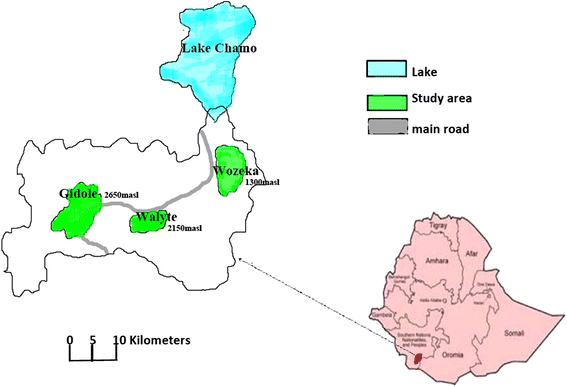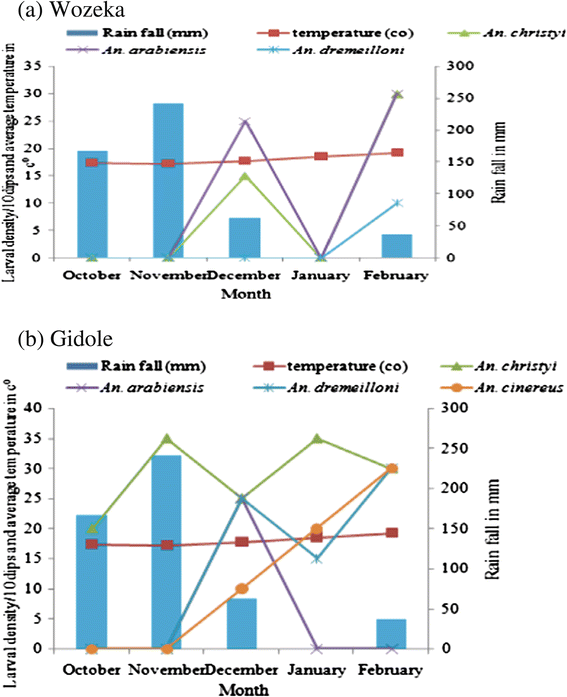Comparative entomological study on ecology and behaviour of Anopheles mosquitoes in highland and lowland localities of Derashe District, southern Ethiopia
- PMID: 25326716
- PMCID: PMC4207323
- DOI: 10.1186/s13071-014-0483-9
Comparative entomological study on ecology and behaviour of Anopheles mosquitoes in highland and lowland localities of Derashe District, southern Ethiopia
Abstract
Background: Change in climatic and socio-economic situations is paving the way for the spread of malaria in highland areas which were generally known to be malaria free. Despite this, information regarding highland malaria transmission is scarce. Thus, the present study investigated entomological parameters linked to malaria transmission in the highlands of Southern Ethiopia.
Methods: A longitudinal entomological study was conducted in three localities situated at different altitudes ranging between 1300 and 2650m above sea level in Derashe district, Southern Ethiopia. Larval and adult anopheline mosquitoes were collected between October 2011 and February 2012.
Results: An. arabiensis and An. funestus s.l existed at significantly higher densities in the lowland (Wozeka) in contrast to An. christyi and An. Demeilloni, which were more abundant in the highland localities (P < 0.01). Conversely, An. pharoensis and An. cinereus were scarce and only found in the lowland and highlands, respectively. Habitats of larvae of An. arabiensis were characterized as clear, sun-lit, permanent, still water (streams) without vegetation and situated close to human habitations. On the other hand, habitats of An. christyi are shaded, still, turbid and contain natural water (rain pools) with vegetation and mats of algae. The relative abundance of An. Arabiensis, which is the primary malaria vector in Ethiopia is significantly and positively correlated with water temperature, pH and average depth (P < 0.05). An. arabiensis, An. funestus s.l and An. demeilloni showed zoophilic and exophilic tendencies. None of the anophelines tested for P. falciparum and P. vivax sporozoite infections were positive.
Conclusion: In conclusion, malaria parasites and vectors existed in the highlands of Derashe District. Therefore, appropriate disease and vector control strategies must be designed and implemented to prevent potential outbreaks.
Figures



Similar articles
-
Review of Anopheles Mosquito Species, Abundance, and Distribution in Ethiopia.J Trop Med. 2021 Sep 23;2021:6726622. doi: 10.1155/2021/6726622. eCollection 2021. J Trop Med. 2021. PMID: 34603455 Free PMC article. Review.
-
Variation in species composition and infection rates of Anopheles mosquitoes at different altitudinal transects, and the risk of malaria in the highland of Dirashe Woreda, south Ethiopia.Parasit Vectors. 2017 Jul 19;10(1):343. doi: 10.1186/s13071-017-2288-0. Parasit Vectors. 2017. PMID: 28724450 Free PMC article.
-
Abundance and dynamics of anopheline larvae in a highland malarious area of south-central Ethiopia.Parasit Vectors. 2012 Jun 13;5:117. doi: 10.1186/1756-3305-5-117. Parasit Vectors. 2012. PMID: 22695178 Free PMC article.
-
Blood meal sources and entomological inoculation rates of anophelines along a highland altitudinal transect in south-central Ethiopia.Malar J. 2013 Feb 23;12:76. doi: 10.1186/1475-2875-12-76. Malar J. 2013. PMID: 23433348 Free PMC article.
-
Study on the species composition and ecology of anophelines in Addis Zemen, South Gondar, Ethiopia.Parasit Vectors. 2018 Mar 27;11(1):215. doi: 10.1186/s13071-018-2701-3. Parasit Vectors. 2018. PMID: 29587821 Free PMC article.
Cited by
-
Spatial analyses of Plasmodium knowlesi vectors with reference to control interventions in Malaysia.Parasit Vectors. 2023 Oct 9;16(1):355. doi: 10.1186/s13071-023-05984-x. Parasit Vectors. 2023. PMID: 37814287 Free PMC article.
-
Review of Anopheles Mosquito Species, Abundance, and Distribution in Ethiopia.J Trop Med. 2021 Sep 23;2021:6726622. doi: 10.1155/2021/6726622. eCollection 2021. J Trop Med. 2021. PMID: 34603455 Free PMC article. Review.
-
Assessing Anopheles species collection techniques in a low malaria transmission area: implications for vector surveillance and control.Malar J. 2025 Jul 1;24(1):204. doi: 10.1186/s12936-025-05463-x. Malar J. 2025. PMID: 40597339 Free PMC article.
-
Variation in species composition and infection rates of Anopheles mosquitoes at different altitudinal transects, and the risk of malaria in the highland of Dirashe Woreda, south Ethiopia.Parasit Vectors. 2017 Jul 19;10(1):343. doi: 10.1186/s13071-017-2288-0. Parasit Vectors. 2017. PMID: 28724450 Free PMC article.
-
High connectivity and low differentiation of Plasmodium falciparum parasite populations in a setting with high seasonal migration.Res Sq [Preprint]. 2025 Jul 2:rs.3.rs-6771360. doi: 10.21203/rs.3.rs-6771360/v1. Res Sq. 2025. PMID: 40630523 Free PMC article. Preprint.
References
-
- Senay G, Verdin J. National Center for EROS. San Diego: 25th Annual ESRI International User Conference; 2005. Developing a Malaria Early Warning System for Ethiopia; p. UC2409.
-
- Tchuinkam T, Simard F, Lélé-Defo E, Téné-Fossog B, Tateng-Ngouateu A, Antonio-Nkondjio C, Mpoame M, Toto JC, Njiné T, Fontenille D, Awono-Ambéné HP. Bionomics of anopheline species and malaria transmission dynamics along an altitudinal transect in western Cameroon. BMC Inf Dis. 2010;10:119. doi: 10.1186/1471-2334-10-119. - DOI - PMC - PubMed
-
- Abeku AT. Malaria Epidemics in Africa; Prediction, Detection and Response. PhD Thesis: Erasmus University Rotterdam. Enschede: Ipskamp; 2006.
MeSH terms
LinkOut - more resources
Full Text Sources
Other Literature Sources

